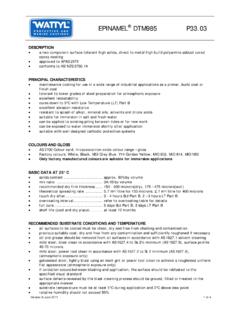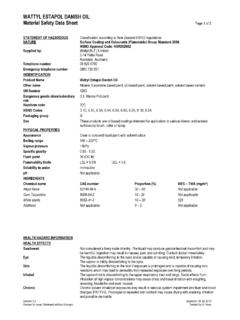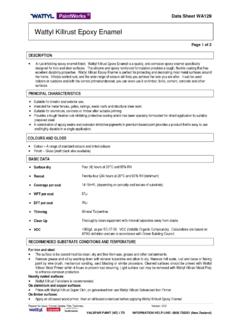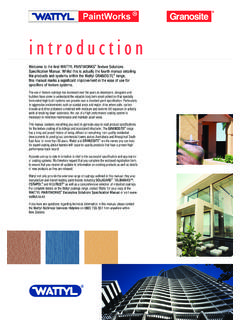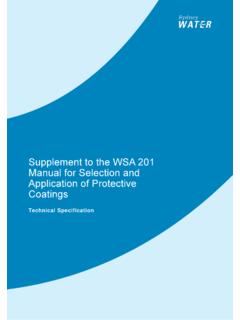Transcription of WATTYL CRAFTSMAN PIGMENT STAIN COLOUR …
1 Section 1 - CHEMICAL PRODUCT AND COMPANY IDENTIFICATION PRODUCT NAME WATTYL CRAFTSMAN PIGMENT STAIN COLOUR RANGE SYNONYMS "Product Code: 1855 Line", "includes all tint bases and tinted colours" PROPER SHIPPING NAME PAINT (including paint, lacquer, enamel, STAIN , shellac, varnish, polish, liquid filler and liquid lacquer base) or PRODUCT USE The use of a quantity of material in an unventilated or confined space may result in increased exposure and an irritating atmosphere developing. Before starting consider control of exposure by mechanical ventilation. Used according to manufacturer's directions. SUPPLIER Company: WATTYL Pty Ltd Address: 4 Steel Street Blacktown NSW, 2148 AUS Telephone: +61 2 9621 6255 Emergency Tel: 1800 039 008 Fax: +61 2 9831 4244 Email: Section 2 - HAZARDS IDENTIFICATION STATEMENT OF HAZARDOUS NATURE HAZARDOUS SUBSTANCE.
2 DANGEROUS GOODS. According to NOHSC Criteria, and ADG Code. POISONS SCHEDULE S5 RISK Risk Codes Risk Phrases R11 Highly flammable. R36/37 Irritating to eyes and respiratory system. R51/53 Toxic to aquatic organisms may cause long- term adverse effects in the aquatic environment. R65 HARMFUL- May cause lung damage if swallowed. R66 Repeated exposure may cause skin dryness and cracking. R67 Vapours may cause drowsiness and dizziness. SAFETY Safety Codes Safety Phrases S36 Wear suitable protective clothing. S51 Use only in well ventilated areas. S401 To clean the floor and all objects contaminated by this material use water and detergent. S35 This material and its container must be disposed of in a safe way.
3 S13 Keep away from food drink and animal feeding stuffs. S46 If swallowed IMMEDIATELY contact Doctor or Poisons Information Centre. (show this container or label). S57 Use appropriate container to avoid environmental contamination. S61 Avoid release to the environment. Refer to special instructions/Safety data sheets. S60 This material and its container must be disposed of as hazardous waste. Section 3 - COMPOSITION / INFORMATION ON INGREDIENTS Section 4 - FIRST AID MEASURES SWALLOWED If swallowed do NOT induce vomiting. If vomiting occurs, lean patient forward or place on left side (head-down position, if possible) to maintain open airway and prevent aspiration. Observe the patient carefully. Never give liquid to a person showing signs of being sleepy or with reduced awareness; becoming unconscious.
4 Avoid giving milk or oils. Avoid giving alcohol. If spontaneous vomiting appears imminent or occurs, hold patient's head down, lower than their hips to help avoid possible aspiration of vomitus. EYE If this product comes in contact with the eyes: Wash out immediately with fresh running water. Ensure complete irrigation of the eye by keeping eyelids apart and away from eye and moving the eyelids by occasionally lifting the upper and lower lids. Seek medical attention without delay; if pain persists or recurs seek medical attention. Removal of contact lenses after an eye injury should only be undertaken by skilled personnel. SKIN If skin contact occurs: Immediately remove all contaminated clothing, including footwear. Flush skin and hair with running water (and soap if available). WATTYL CRAFTSMAN PIGMENT STAIN COLOUR RANGE Chemwatch Independent Material Safety Data SheetIssue Date: 20-Apr-2010 XC9317EC CHEMWATCH 55705 Version No:4 (Interim)NAMECAS RN%aromatic hydrocarbon asmethyl ethyl ketone78-93-310-30pigments unregulated<10synthetic resins10-30additives<10contains less than benzene Seek medical attention in event of irritation.
5 INHALED If fumes or combustion products are inhaled remove from contaminated area. Lay patient down. Keep warm and rested. Prostheses such as false teeth, which may block airway, should be removed, where possible, prior to initiating first aid procedures. Apply artificial respiration if not breathing, preferably with a demand valve resuscitator, bag-valve mask device, or pocket mask as trained. Perform CPR if necessary. NOTES TO PHYSICIAN Any material aspirated during vomiting may produce lung injury. Therefore emesis should not be induced mechanically or pharmacologically. For acute or short term repeated exposures to petroleum distillates or related hydrocarbons: Primary threat to life, from pure petroleum distillate ingestion and/or inhalation, is respiratory failure. Patients should be quickly evaluated for signs of respiratory distress ( cyanosis, tachypnoea, intercostal retraction, obtundation) and given oxygen.
6 Patients with inadequate tidal vo Arrhythmias complicate some hydrocarbon ingestion and/or inhalation and electrocardiographic evidence of myocardial injury has been reported; intravenous lines and cardiac monitor A chest x-ray should be taken immediately after stabilisation of breathing and circulation to document aspiration and detect the presence of pneumothorax. for simple ketones: ---------------------------------------- ---------------------- BASIC TREATMENT ---------------------------------------- ---------------------- Establish a patent airway with suction where necessary. Watch for signs of respiratory insufficiency and assist ventilation as necessary. Administer oxygen by non-rebreather mask at 10 to 15 l/min. Monitor and treat, where necessary, for pulmonary oedema . Section 5 - FIRE FIGHTING MEASURES EXTINGUISHING MEDIA Foam. Dry chemical powder. BCF (where regulations permit). Carbon dioxide. FIRE FIGHTING Alert Fire Brigade and tell them location and nature of hazard.
7 May be violently or explosively reactive. Wear breathing apparatus plus protective gloves. Prevent, by any means available, spillage from entering drains or water course. When any large container (including road and rail tankers) is involved in a fire, consider evacuation by 500 metres in all directions. FIRE/EXPLOSION HAZARD Liquid and vapour are highly flammable. Severe fire hazard when exposed to heat, flame and/or oxidisers. Vapour may travel a considerable distance to source of ignition. Heating may cause expansion or decomposition leading to violent rupture of containers. Combustion products include: carbon dioxide (CO2), other pyrolysis products typical of burning organic material. Contains low boiling substance: Closed containers may rupture due to pressure buildup under fire conditions. FIRE INCOMPATIBILITY Avoid contamination with oxidising agents nitrates, oxidising acids, chlorine bleaches, pool chlorine etc.
8 As ignition may result. HAZCHEM 3YE PERSONAL PROTECTION Section 6 - ACCIDENTAL RELEASE MEASURES MINOR SPILLS Remove all ignition sources. Clean up all spills immediately. Avoid breathing vapours and contact with skin and eyes. Control personal contact by using protective equipment. MAJOR SPILLS Clear area of personnel and move upwind. Alert Fire Brigade and tell them location and nature of hazard. May be violently or explosively reactive. Wear breathing apparatus plus protective gloves. Personal Protective Equipment advice is contained in Section 8 of the MSDS. Section 7 - HANDLING AND STORAGE PROCEDURE FOR HANDLING Containers, even those that have been emptied, may contain explosive vapours. Do NOT cut, drill, grind, weld or perform similar operations on or near containers. DO NOT allow clothing wet with material to stay in contact with skin. Electrostatic discharge may be generated during pumping - this may result in fire.
9 Ensure electrical continuity by bonding and grounding (earthing) all equipment. Restrict line velocity during pumping in order to avoid generation of electrostatic discharge (<=1 m/sec until fill pipe submerged to twice its diameter, then <= 7 m/sec). Avoid splash filling. Avoid all personal contact, including inhalation. Wear protective clothing when risk of exposure occurs. Use in a well-ventilated area. Prevent concentration in hollows and sumps. SUITABLE CONTAINER Packing as supplied by manufacturer. Plastic containers may only be used if approved for flammable liquid. Check that containers are clearly labelled and free from leaks. For low viscosity materials (i) : Drums and jerry cans must be of the non-removable head type. (ii) : Where a can is to be used as an inner package, the can must have a screwed enclosure. For materials with a viscosity of at least 2680 cSt. (23 deg. C) For manufactured product having a viscosity of at least 250 cSt.
10 (23 deg. C) Manufactured product that requires stirring before use and having a viscosity of at least 20 cSt (25 deg. C). STORAGE INCOMPATIBILITY Avoid strong bases. Ketones in this group: are reactive with many acids and bases liberating heat and flammable gases ( , H2). react with reducing agents such as hydrides, alkali metals, and nitrides to produce flammable gas (H2) and heat. are incompatible with isocyanates, aldehydes, cyanides, peroxides, and anhydrides. react violently with aldehydes, HNO3 (nitric acid), HNO3 + H2O2 (mixture of nitric acid and hydrogen peroxide), and HClO4 (perchloric acid). Avoid reaction with oxidising agents. STORAGE REQUIREMENTS Store in original containers in approved flame-proof area. Glasses: Gloves: Respirator: Chemical goggles.




